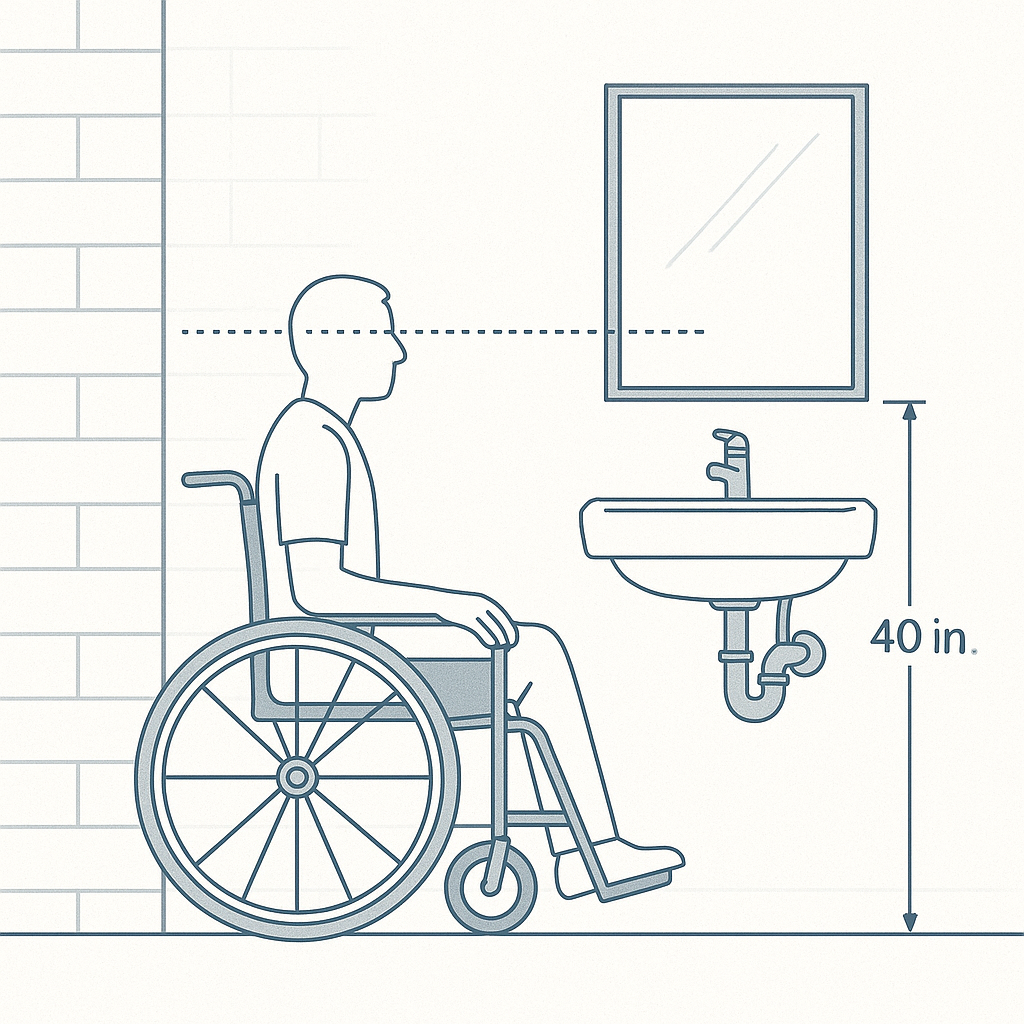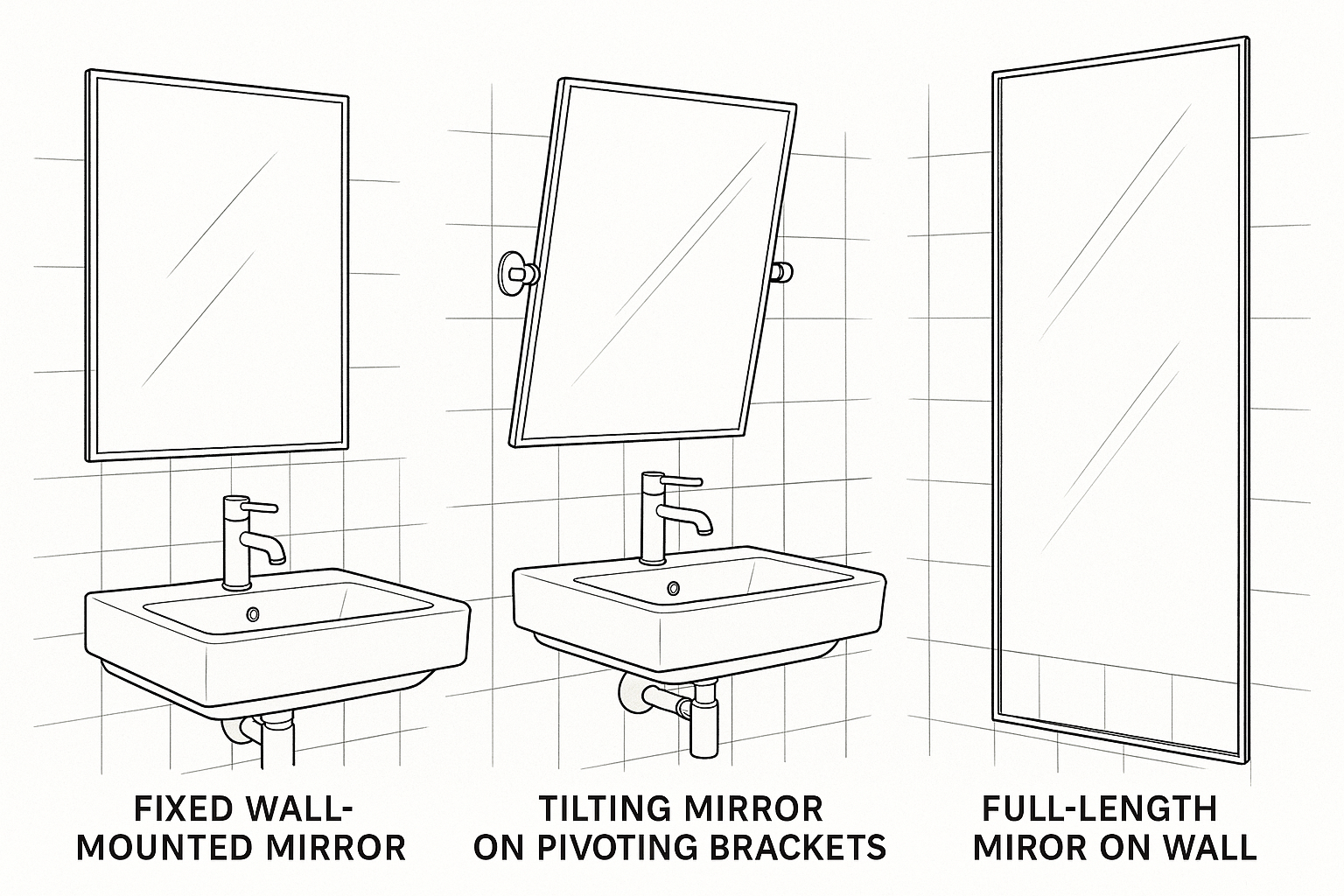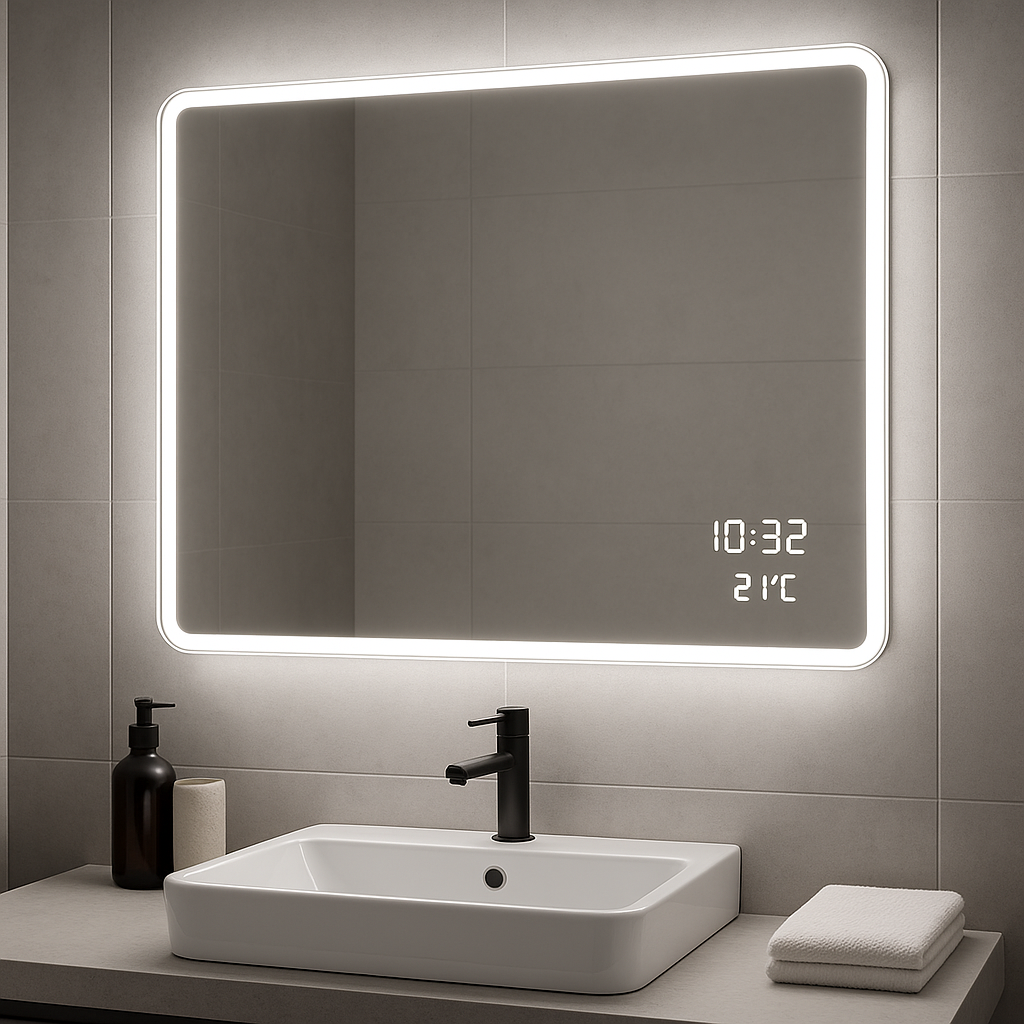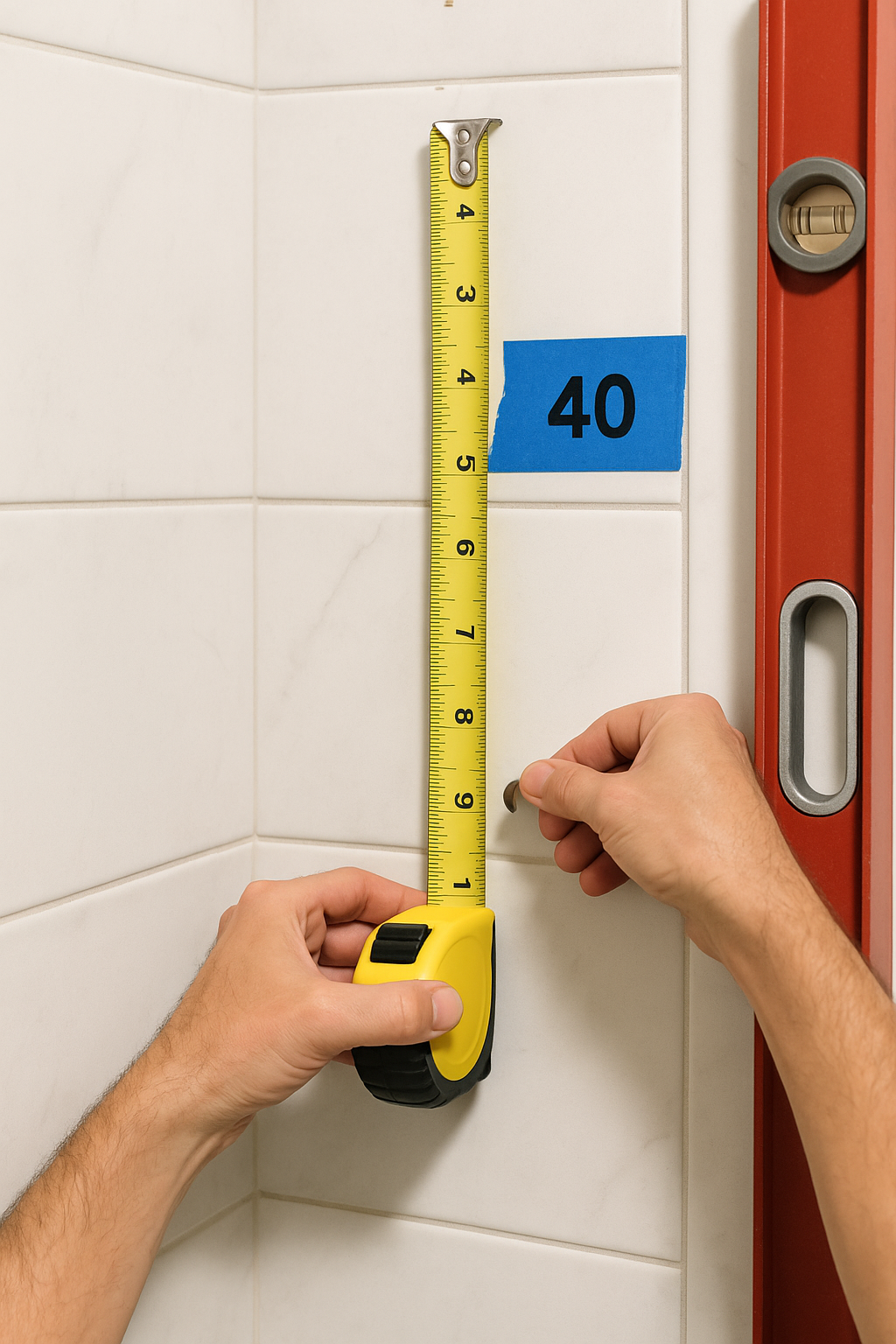Complete Guide to ADA Bathroom Mirrors: Requirements, Installation, and Product Recommendations

Complete Guide to ADA Bathroom Mirrors: Requirements, Installation, and Product Recommendations
When you're designing or renovating a bathroom to meet accessibility standards, every detail matters. Among these crucial elements, the ADA bathroom mirror often gets overlooked, yet it plays a vital role in creating a truly inclusive space. Whether you're a contractor working on a commercial project, a homeowner making your home more accessible, or a facility manager ensuring compliance, understanding ADA mirror bathroom requirements isn't just about following regulations; it's about creating spaces where everyone can comfortably perform daily tasks with dignity and independence.
I've spent the past decade working with architects and accessibility consultants on various bathroom renovation projects, and I've seen firsthand how the right mirror placement can make or break the functionality of an accessible bathroom. The difference between a properly installed handicap bathroom mirror and one that's even a few inches off can mean the difference between independence and frustration for wheelchair users.
This comprehensive guide will walk you through everything you need to know about ADA bathroom mirrors, from specific mounting requirements to product recommendations that combine compliance with style. You'll learn how to avoid common installation mistakes, understand the reasoning behind each regulation, and discover modern solutions like bathroom smart mirrors that can enhance accessibility while adding contemporary features to your space.
Understanding ADA Mirror Requirements
The Americans with Disabilities Act (ADA) sets specific standards for bathroom mirrors to ensure they're accessible to people using wheelchairs and those with mobility challenges. The most critical requirement? The bottom edge of the reflecting surface must be no higher than 40 inches above the finish floor.
This bathroom mirror height ADA measurement isn't arbitrary, it's based on extensive research into the average eye level of seated wheelchair users. When I first started working with ADA specifications, I made the mistake of measuring from the mirror frame rather than the actual reflecting surface. This small oversight meant redoing an entire installation, a costly lesson that taught me to pay attention to every detail in the regulations.
Key ADA Bathroom Mirror Requirements:

The 40-inch maximum height applies specifically to the bottom edge of the reflecting surface, not the frame. This distinction is crucial because decorative frames can add several inches, potentially pushing the actual mirror surface out of compliance.
Beyond height requirements, consider these additional factors:
- The mirror should be mounted above or adjacent to the lavatory
- Tilted mirrors can help accommodate both standing and seated users
- Full length mirrors on walls or doors provide additional viewing options
Understanding the Purpose Behind ADA Mirror Height Bathroom Requirements
The ADA mirror height bathroom standard exists to serve users at various heights and positions. A person in a wheelchair typically has an eye level between 43 and 51 inches from the floor, significantly lower than someone standing. The 40-inch requirement ensures that seated users can see their face and upper body in the mirror.
During a recent hotel renovation project, we installed adjustable-tilt mirrors that could accommodate both wheelchair users and standing guests. This solution, while not required by ADA standards, demonstrated how thoughtful design can exceed minimum requirements to create truly universal access.
Types of ADA Compliant Bathroom Mirrors

Not all mirrors are created equal when it comes to ADA compliance. Through years of installations, I've worked with various styles that meet accessibility requirements while offering different benefits for specific environments.
Fixed Wall-Mounted Mirrors
Traditional fixed mirrors remain the most common choice for ADA compliant bathroom mirrors. These permanent installations offer stability and durability, making them ideal for high-traffic commercial bathrooms. When specifying an ada mirror bathroom solution, the key is ensuring proper mounting height—I always use a laser level and mark the exact position of the reflecting surface before drilling any holes.
Tilting Mirrors
Tilting mirrors represent an excellent compromise between accessibility and versatility. These mirrors pivot on a horizontal axis, allowing users to adjust the angle to their needs. I particularly recommend these handicap bathroom mirror options for residential bathrooms where family members of varying heights share the space.
Full-Length Mirrors
While not specifically required by ADA standards, full-length mirrors mounted on walls or doors provide additional viewing options. In one memorable project for a rehabilitation center, we installed full-length mirrors on bathroom doors, giving wheelchair users the ability to check their full appearance—something the standard above-sink mirror couldn't provide.
Smart Mirrors for Enhanced Accessibility

The emergence of bathroom smart mirrors has opened new possibilities for accessible design. These high-tech solutions can offer features like:
- Voice-activated controls
- Adjustable LED lighting for users with visual impairments
- Anti-fog technology for consistent visibility
- Built-in magnification zones
I recently installed a smart mirror in an assisted living facility that included voice commands for lighting adjustment. Residents with limited hand mobility could control the mirror's features without reaching for switches, demonstrating how technology can enhance accessibility beyond basic ADA bathroom mirror requirements.
How to Install an ADA Bathroom Mirror
Proper installation of an ADA bathroom mirror requires precision and attention to detail. After dozens of installations, I've developed a systematic approach that ensures compliance every time.
Step 1: Measure and Mark

Start by measuring 40 inches from the finished floor—this marks the maximum height for the bottom edge of the reflecting surface. Remember, if your mirror has a frame, account for its width. I use painter's tape to create a visual guide on the wall, marking both the 40-inch line and the desired mirror position.
Step 2: Check for Obstructions
Before drilling, verify that no pipes, electrical wires, or structural elements lie behind your mounting area. A stud finder with electrical detection capabilities has saved me from costly mistakes more than once.
Step 3: Consider the Lavatory Position
The ADA restroom mirror should align with the lavatory for optimal use. Measure the sink's center point and ensure your mirror placement provides adequate coverage. In smaller bathrooms, I often recommend wider mirrors that extend beyond the sink edges, providing better visibility for users approaching from different angles.
Step 4: Secure Mounting
Use appropriate anchors for your wall type—drywall anchors for hollow walls, or screws directly into studs for heavier mirrors. For commercial installations, I always specify heavy-duty mounting systems that can withstand frequent use and potential impact.
Step 5: Final Verification
After installation, double-check the measurement from floor to the bottom edge of the reflecting surface. This final check of your ada bathroom mirror height is crucial for compliance. Take photos for documentation—many inspectors appreciate this attention to detail during compliance reviews.
Common Installation Mistakes to Avoid
Through years of experience and observing others' work, I've cataloged the most frequent errors in ADA bathroom mirror installation:
Measuring from the Frame Instead of the Reflecting Surface: This remains the most common mistake I encounter. Always measure to the actual mirror surface, not the decorative frame.
Ignoring Tilted Installations: If installing a tilting mirror, ensure it meets the 40-inch requirement when tilted to its most upright position. I've seen installations pass initial inspection only to fail when the mirror's tilt was adjusted.
Forgetting About Mounting Hardware: Protruding mounting brackets can create hazards for visually impaired users. Choose flush-mount or recessed hardware whenever possible.
Improper Height Above Lavatories: While focusing on the 40-inch rule, some installers position mirrors too low above sinks, creating awkward viewing angles for standing users. Understanding bathroom mirror height ADA requirements means balancing accessibility with practical use for all users.
Product Recommendations for Different Settings
Selecting the right ADA compliant bathroom mirror depends on your specific environment and user needs. Based on extensive field experience, here are my recommendations for various settings:
Commercial Facilities
For high-traffic areas like restaurants, offices, and retail spaces, durability takes priority. I recommend:
- Stainless steel-framed mirrors with shatter-resistant glass
- Fixed mounting systems with concealed fasteners
- Dimensions of at least 18" x 30" for adequate viewing area
The Bobrick B-165 series has proven exceptionally reliable in my commercial projects, offering both durability and compliance with all ADA standards.
Healthcare Facilities
Medical environments demand mirrors that support both hygiene and accessibility:
- Frameless designs that minimize dust accumulation
- Tempered glass for safety
- Anti-microbial coatings where available
When selecting ada bathroom mirrors for healthcare settings, prioritize easy-to-clean surfaces and robust mounting systems that can withstand frequent sanitization.
Residential Bathrooms
Home installations allow more flexibility in style while maintaining compliance:
- Decorative frames that complement bathroom décor
- Tilting mechanisms for multi-user households
- Integrated lighting for enhanced visibility
I've had excellent results with the Gatco Marina series, which offers elegant tilting mirrors that easily meet ADA requirements while adding style to residential bathrooms.
Smart Mirror Solutions
For those interested in bathroom smart mirrors, several manufacturers now offer ADA-compliant options:
- The Kohler Verdera Voice mirror combines voice control with appropriate mounting heights
- HiMirror models can be mounted at ADA-compliant heights while offering skin analysis features
- Electric Mirror's Integrity series provides customizable sizes with smart features
Maintenance and Long-term Compliance
Installing an ADA bathroom mirror correctly is just the beginning—maintaining compliance requires ongoing attention. Regular inspections should verify:
- Mounting hardware remains secure
- No damage affects the 40-inch height requirement
- Reflective surface stays clear and undistorted
In facilities I've worked with long-term, I recommend quarterly inspections as part of routine maintenance. Document any repairs or adjustments to maintain compliance records.
Cost Considerations and Budgeting
ADA bathroom mirror costs vary significantly based on size, features, and quality. Through numerous projects, I've observed these general price ranges:
- Basic fixed mirrors: $50-$200
- Quality tilting mirrors: $150-$400
- Smart mirrors with accessibility features: $500-$2,000
- Custom solutions for specific needs: $300-$1,000
Remember that installation costs can add 50-100% to the mirror price, depending on wall conditions and mounting complexity. Budget accordingly, and consider that investing in quality upfront often reduces long-term maintenance costs.
Future Trends in Accessible Mirror Design
The future of ADA bathroom mirrors looks increasingly tech-enabled. Emerging trends I'm watching include:
- Adjustable-height mirrors with motorized mechanisms
- Augmented reality features for visual assistance
- Integration with smart home systems
- Sustainable materials and energy-efficient lighting
These innovations promise to enhance accessibility while adding convenience for all users.
Conclusion
Creating truly accessible bathrooms requires attention to every detail, and the ADA bathroom mirror plays a crucial role in this equation. The 40-inch maximum height requirement isn't just a number—it represents a commitment to universal design that serves everyone.
Whether you're installing a basic fixed mirror or exploring bathroom smart mirror options, success comes from understanding both the letter and spirit of ADA requirements. Consider your specific users' needs, choose quality products appropriate for your environment, and always prioritize correct installation.
Remember that accessibility improvements benefit everyone. A mirror positioned correctly for wheelchair users often works better for children and shorter adults too. By following the guidelines and recommendations in this guide, you'll create bathroom spaces that truly serve all users with dignity and independence.
Frequently Asked Questions
What is the exact ADA bathroom mirror height requirement? The bottom edge of the mirror's reflecting surface must be mounted no higher than 40 inches above the finished floor. This measurement applies to the actual mirror surface, not the frame.
Do tilting mirrors need to meet ADA requirements in all positions? Yes, tilting mirrors must meet the 40-inch requirement when in their most upright position. This ensures compliance regardless of how users adjust the mirror angle.
Can I install multiple mirrors at different heights? Yes, you can install multiple mirrors to accommodate various users. However, at least one mirror must meet ADA requirements. Many facilities install both standard-height and ADA-compliant mirrors.
Are there specific ADA requirements for mirror width or size? The ADA doesn't specify minimum width requirements for mirrors. However, mirrors should be wide enough to be functional—typically at least 16 inches wide for adequate viewing.
Do residential bathrooms need to follow ADA mirror requirements? Private residences aren't required to follow ADA standards unless they're used for public accommodation. However, following these guidelines creates more accessible homes for aging in place or accommodating visitors with disabilities.
What's the difference between ADA and local building code requirements? ADA provides federal accessibility standards, while local codes may have additional requirements. Always check both ADA standards and local building codes—you must meet whichever is more stringent.
Sources and References
- ADA Standards for Accessible Design (2010): Section 603.3 - Mirrors
https://www.ada.gov/regs2010/2010ADAStandards/2010ADAstandards.htm
- ADA Compliance Guide - Lavatories and Mirrors
https://www.ada-compliance.com/ada-compliance/ada-lavatories-mirrors.html